Agricultural Reforms in Australia: Market and Policy Analysis
VerifiedAdded on 2020/03/04
|9
|1437
|148
Report
AI Summary
This report critically examines agricultural reforms in Australia, focusing on the country's reliance on free market policies compared to regulated markets. It analyzes the economic theories and concepts related to agricultural subsidies and their impact on market equilibrium, highlighting the inefficiencies of subsidy policies and the advantages of a free market approach. The report evaluates the Australian government's approach, which provides minimal assistance to the agricultural sector, and recommends indirect government assistance through investments in research and technology, providing advanced machinery, and protecting food crops from import competition to improve productivity and competitiveness. The analysis uses economic models to illustrate the effects of subsidies and free market conditions, offering a comprehensive understanding of the agricultural sector's structure and potential for sustainable growth.
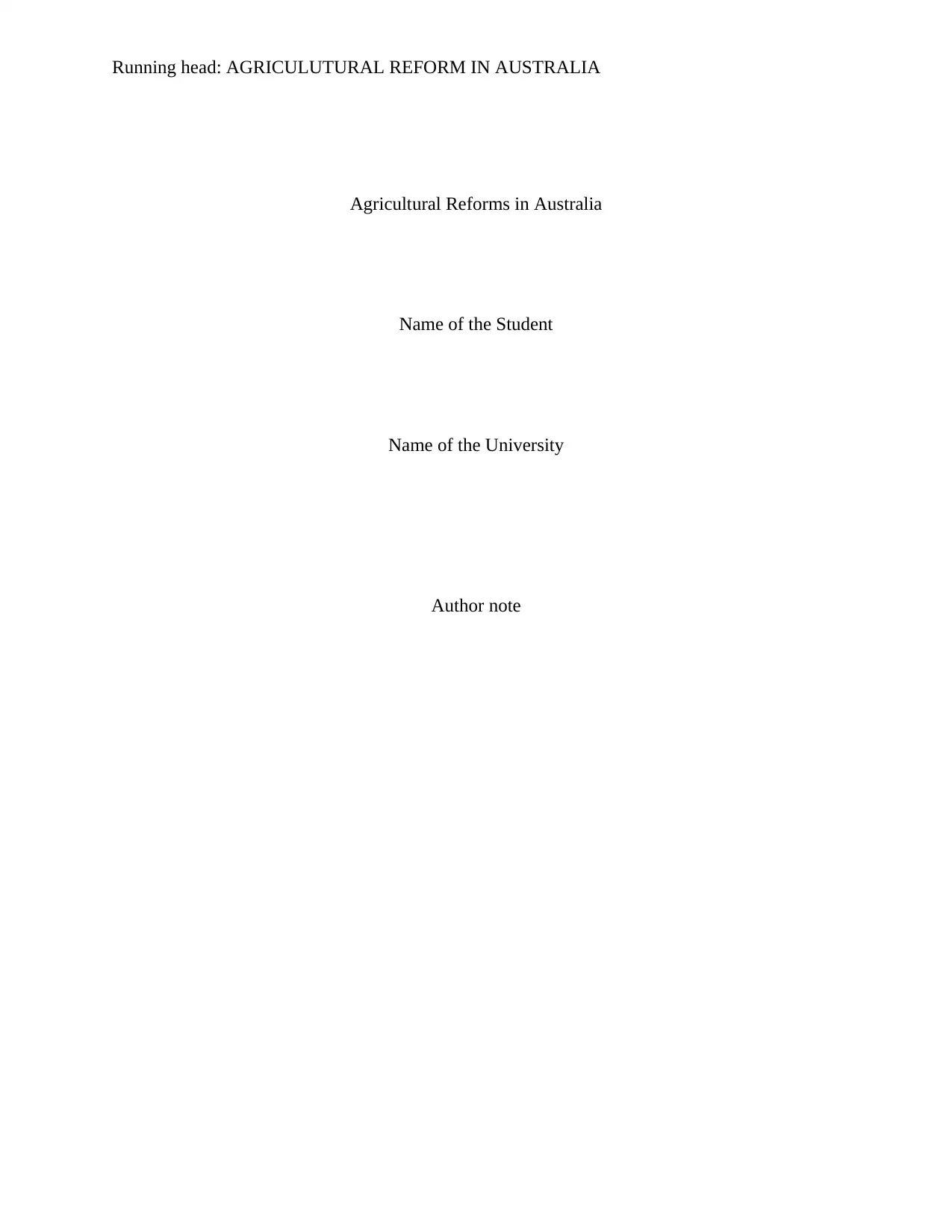
Running head: AGRICULUTURAL REFORM IN AUSTRALIA
Agricultural Reforms in Australia
Name of the Student
Name of the University
Author note
Agricultural Reforms in Australia
Name of the Student
Name of the University
Author note
Paraphrase This Document
Need a fresh take? Get an instant paraphrase of this document with our AI Paraphraser
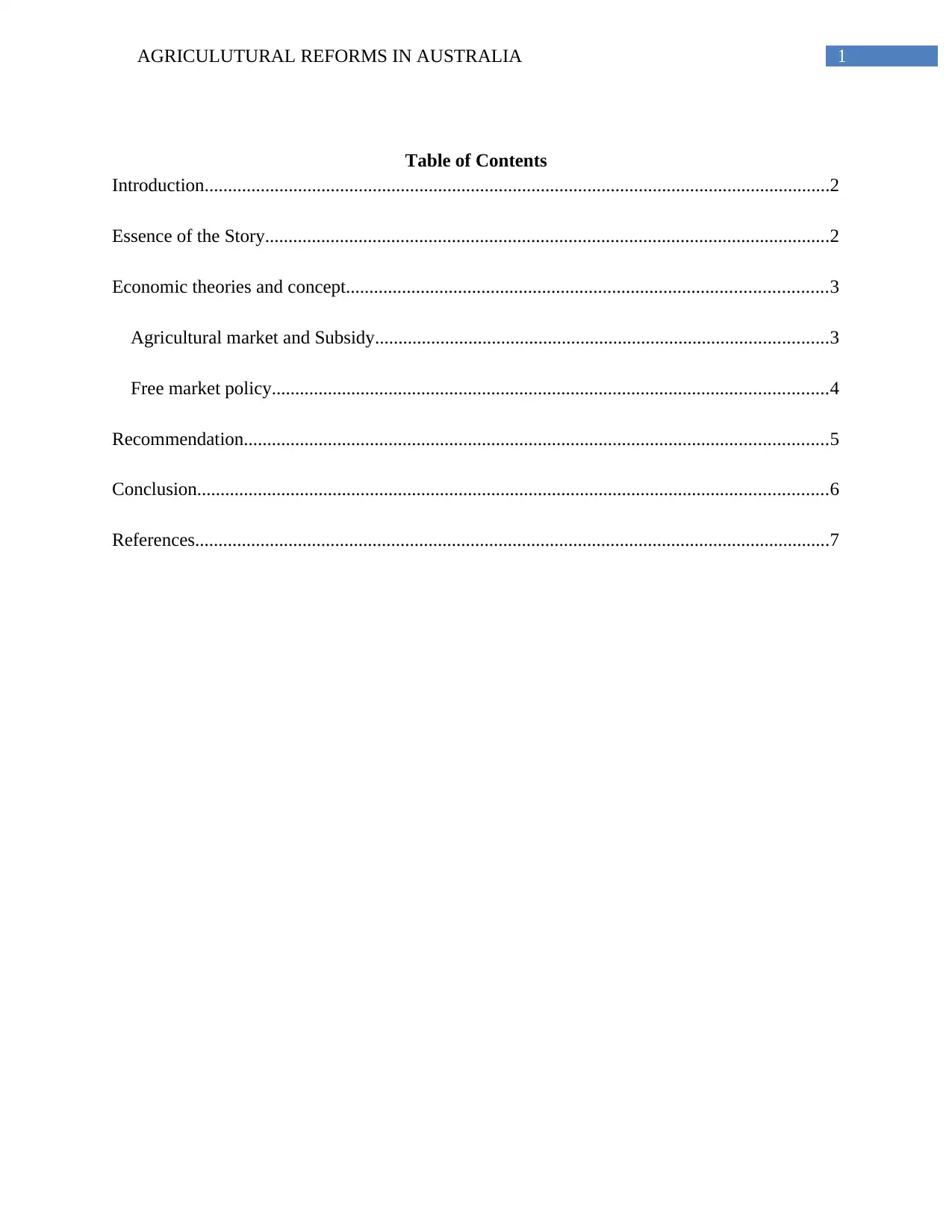
1AGRICULUTURAL REFORMS IN AUSTRALIA
Table of Contents
Introduction......................................................................................................................................2
Essence of the Story.........................................................................................................................2
Economic theories and concept.......................................................................................................3
Agricultural market and Subsidy.................................................................................................3
Free market policy.......................................................................................................................4
Recommendation.............................................................................................................................5
Conclusion.......................................................................................................................................6
References........................................................................................................................................7
Table of Contents
Introduction......................................................................................................................................2
Essence of the Story.........................................................................................................................2
Economic theories and concept.......................................................................................................3
Agricultural market and Subsidy.................................................................................................3
Free market policy.......................................................................................................................4
Recommendation.............................................................................................................................5
Conclusion.......................................................................................................................................6
References........................................................................................................................................7
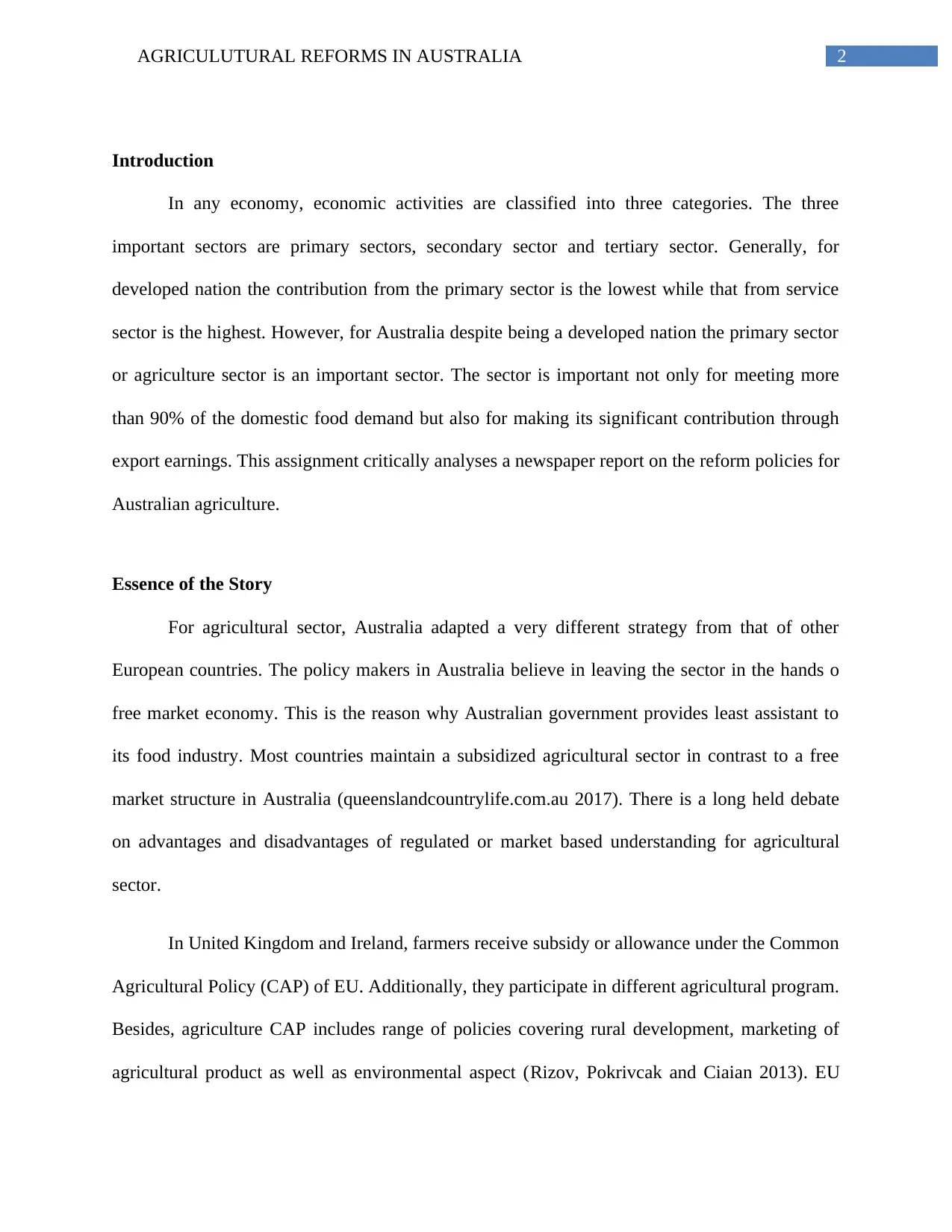
2AGRICULUTURAL REFORMS IN AUSTRALIA
Introduction
In any economy, economic activities are classified into three categories. The three
important sectors are primary sectors, secondary sector and tertiary sector. Generally, for
developed nation the contribution from the primary sector is the lowest while that from service
sector is the highest. However, for Australia despite being a developed nation the primary sector
or agriculture sector is an important sector. The sector is important not only for meeting more
than 90% of the domestic food demand but also for making its significant contribution through
export earnings. This assignment critically analyses a newspaper report on the reform policies for
Australian agriculture.
Essence of the Story
For agricultural sector, Australia adapted a very different strategy from that of other
European countries. The policy makers in Australia believe in leaving the sector in the hands o
free market economy. This is the reason why Australian government provides least assistant to
its food industry. Most countries maintain a subsidized agricultural sector in contrast to a free
market structure in Australia (queenslandcountrylife.com.au 2017). There is a long held debate
on advantages and disadvantages of regulated or market based understanding for agricultural
sector.
In United Kingdom and Ireland, farmers receive subsidy or allowance under the Common
Agricultural Policy (CAP) of EU. Additionally, they participate in different agricultural program.
Besides, agriculture CAP includes range of policies covering rural development, marketing of
agricultural product as well as environmental aspect (Rizov, Pokrivcak and Ciaian 2013). EU
Introduction
In any economy, economic activities are classified into three categories. The three
important sectors are primary sectors, secondary sector and tertiary sector. Generally, for
developed nation the contribution from the primary sector is the lowest while that from service
sector is the highest. However, for Australia despite being a developed nation the primary sector
or agriculture sector is an important sector. The sector is important not only for meeting more
than 90% of the domestic food demand but also for making its significant contribution through
export earnings. This assignment critically analyses a newspaper report on the reform policies for
Australian agriculture.
Essence of the Story
For agricultural sector, Australia adapted a very different strategy from that of other
European countries. The policy makers in Australia believe in leaving the sector in the hands o
free market economy. This is the reason why Australian government provides least assistant to
its food industry. Most countries maintain a subsidized agricultural sector in contrast to a free
market structure in Australia (queenslandcountrylife.com.au 2017). There is a long held debate
on advantages and disadvantages of regulated or market based understanding for agricultural
sector.
In United Kingdom and Ireland, farmers receive subsidy or allowance under the Common
Agricultural Policy (CAP) of EU. Additionally, they participate in different agricultural program.
Besides, agriculture CAP includes range of policies covering rural development, marketing of
agricultural product as well as environmental aspect (Rizov, Pokrivcak and Ciaian 2013). EU
⊘ This is a preview!⊘
Do you want full access?
Subscribe today to unlock all pages.

Trusted by 1+ million students worldwide
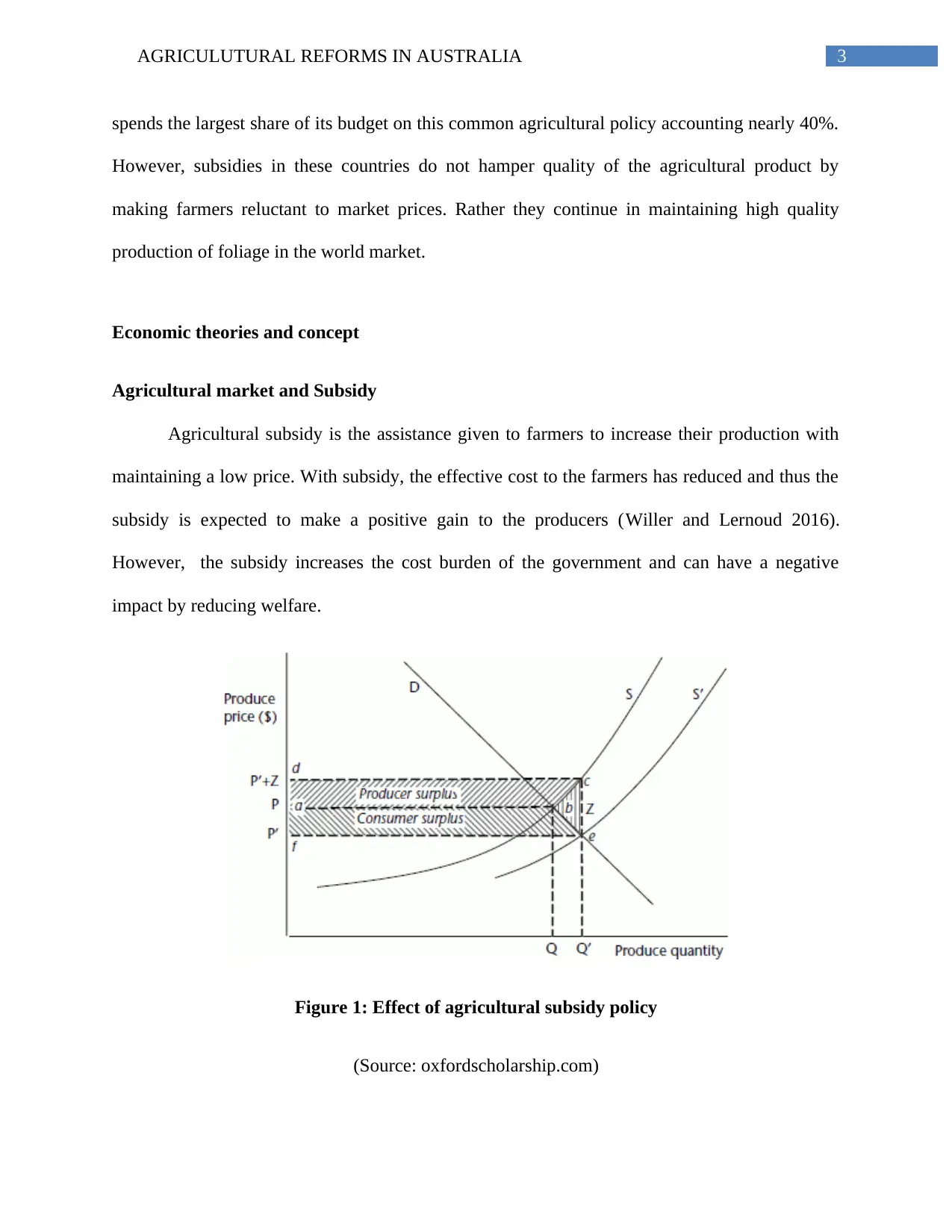
3AGRICULUTURAL REFORMS IN AUSTRALIA
spends the largest share of its budget on this common agricultural policy accounting nearly 40%.
However, subsidies in these countries do not hamper quality of the agricultural product by
making farmers reluctant to market prices. Rather they continue in maintaining high quality
production of foliage in the world market.
Economic theories and concept
Agricultural market and Subsidy
Agricultural subsidy is the assistance given to farmers to increase their production with
maintaining a low price. With subsidy, the effective cost to the farmers has reduced and thus the
subsidy is expected to make a positive gain to the producers (Willer and Lernoud 2016).
However, the subsidy increases the cost burden of the government and can have a negative
impact by reducing welfare.
Figure 1: Effect of agricultural subsidy policy
(Source: oxfordscholarship.com)
spends the largest share of its budget on this common agricultural policy accounting nearly 40%.
However, subsidies in these countries do not hamper quality of the agricultural product by
making farmers reluctant to market prices. Rather they continue in maintaining high quality
production of foliage in the world market.
Economic theories and concept
Agricultural market and Subsidy
Agricultural subsidy is the assistance given to farmers to increase their production with
maintaining a low price. With subsidy, the effective cost to the farmers has reduced and thus the
subsidy is expected to make a positive gain to the producers (Willer and Lernoud 2016).
However, the subsidy increases the cost burden of the government and can have a negative
impact by reducing welfare.
Figure 1: Effect of agricultural subsidy policy
(Source: oxfordscholarship.com)
Paraphrase This Document
Need a fresh take? Get an instant paraphrase of this document with our AI Paraphraser
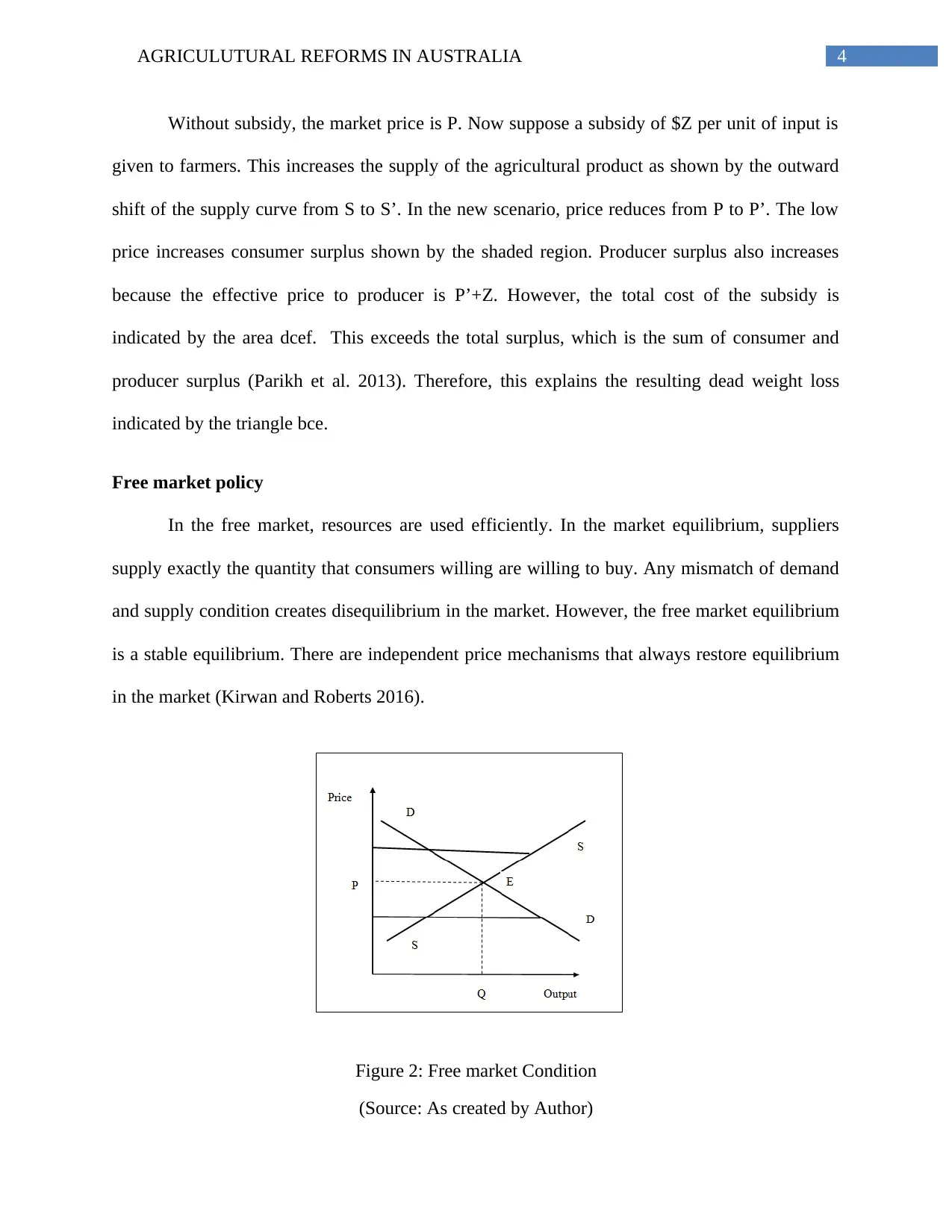
4AGRICULUTURAL REFORMS IN AUSTRALIA
Without subsidy, the market price is P. Now suppose a subsidy of $Z per unit of input is
given to farmers. This increases the supply of the agricultural product as shown by the outward
shift of the supply curve from S to S’. In the new scenario, price reduces from P to P’. The low
price increases consumer surplus shown by the shaded region. Producer surplus also increases
because the effective price to producer is P’+Z. However, the total cost of the subsidy is
indicated by the area dcef. This exceeds the total surplus, which is the sum of consumer and
producer surplus (Parikh et al. 2013). Therefore, this explains the resulting dead weight loss
indicated by the triangle bce.
Free market policy
In the free market, resources are used efficiently. In the market equilibrium, suppliers
supply exactly the quantity that consumers willing are willing to buy. Any mismatch of demand
and supply condition creates disequilibrium in the market. However, the free market equilibrium
is a stable equilibrium. There are independent price mechanisms that always restore equilibrium
in the market (Kirwan and Roberts 2016).
Figure 2: Free market Condition
(Source: As created by Author)
Without subsidy, the market price is P. Now suppose a subsidy of $Z per unit of input is
given to farmers. This increases the supply of the agricultural product as shown by the outward
shift of the supply curve from S to S’. In the new scenario, price reduces from P to P’. The low
price increases consumer surplus shown by the shaded region. Producer surplus also increases
because the effective price to producer is P’+Z. However, the total cost of the subsidy is
indicated by the area dcef. This exceeds the total surplus, which is the sum of consumer and
producer surplus (Parikh et al. 2013). Therefore, this explains the resulting dead weight loss
indicated by the triangle bce.
Free market policy
In the free market, resources are used efficiently. In the market equilibrium, suppliers
supply exactly the quantity that consumers willing are willing to buy. Any mismatch of demand
and supply condition creates disequilibrium in the market. However, the free market equilibrium
is a stable equilibrium. There are independent price mechanisms that always restore equilibrium
in the market (Kirwan and Roberts 2016).
Figure 2: Free market Condition
(Source: As created by Author)
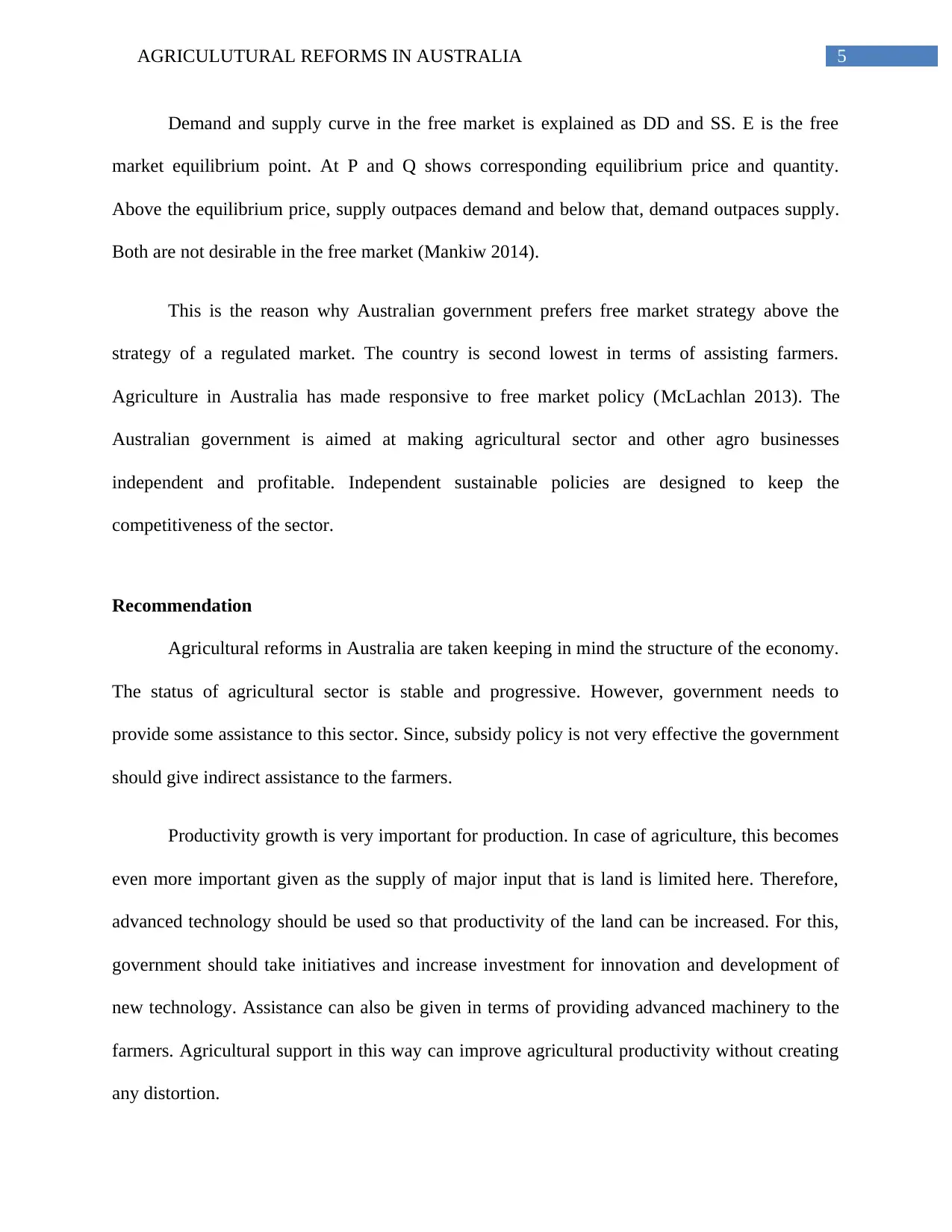
5AGRICULUTURAL REFORMS IN AUSTRALIA
Demand and supply curve in the free market is explained as DD and SS. E is the free
market equilibrium point. At P and Q shows corresponding equilibrium price and quantity.
Above the equilibrium price, supply outpaces demand and below that, demand outpaces supply.
Both are not desirable in the free market (Mankiw 2014).
This is the reason why Australian government prefers free market strategy above the
strategy of a regulated market. The country is second lowest in terms of assisting farmers.
Agriculture in Australia has made responsive to free market policy (McLachlan 2013). The
Australian government is aimed at making agricultural sector and other agro businesses
independent and profitable. Independent sustainable policies are designed to keep the
competitiveness of the sector.
Recommendation
Agricultural reforms in Australia are taken keeping in mind the structure of the economy.
The status of agricultural sector is stable and progressive. However, government needs to
provide some assistance to this sector. Since, subsidy policy is not very effective the government
should give indirect assistance to the farmers.
Productivity growth is very important for production. In case of agriculture, this becomes
even more important given as the supply of major input that is land is limited here. Therefore,
advanced technology should be used so that productivity of the land can be increased. For this,
government should take initiatives and increase investment for innovation and development of
new technology. Assistance can also be given in terms of providing advanced machinery to the
farmers. Agricultural support in this way can improve agricultural productivity without creating
any distortion.
Demand and supply curve in the free market is explained as DD and SS. E is the free
market equilibrium point. At P and Q shows corresponding equilibrium price and quantity.
Above the equilibrium price, supply outpaces demand and below that, demand outpaces supply.
Both are not desirable in the free market (Mankiw 2014).
This is the reason why Australian government prefers free market strategy above the
strategy of a regulated market. The country is second lowest in terms of assisting farmers.
Agriculture in Australia has made responsive to free market policy (McLachlan 2013). The
Australian government is aimed at making agricultural sector and other agro businesses
independent and profitable. Independent sustainable policies are designed to keep the
competitiveness of the sector.
Recommendation
Agricultural reforms in Australia are taken keeping in mind the structure of the economy.
The status of agricultural sector is stable and progressive. However, government needs to
provide some assistance to this sector. Since, subsidy policy is not very effective the government
should give indirect assistance to the farmers.
Productivity growth is very important for production. In case of agriculture, this becomes
even more important given as the supply of major input that is land is limited here. Therefore,
advanced technology should be used so that productivity of the land can be increased. For this,
government should take initiatives and increase investment for innovation and development of
new technology. Assistance can also be given in terms of providing advanced machinery to the
farmers. Agricultural support in this way can improve agricultural productivity without creating
any distortion.
⊘ This is a preview!⊘
Do you want full access?
Subscribe today to unlock all pages.

Trusted by 1+ million students worldwide
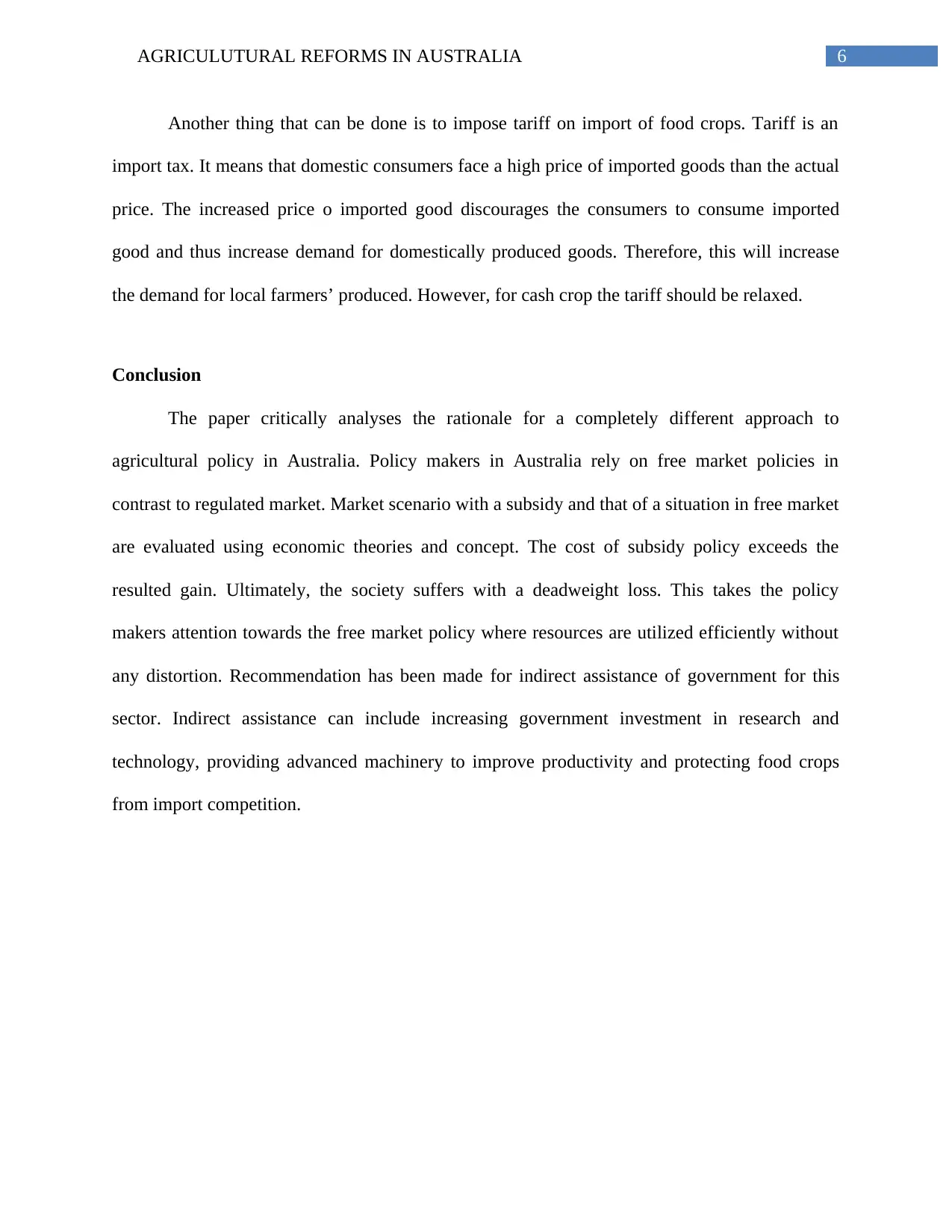
6AGRICULUTURAL REFORMS IN AUSTRALIA
Another thing that can be done is to impose tariff on import of food crops. Tariff is an
import tax. It means that domestic consumers face a high price of imported goods than the actual
price. The increased price o imported good discourages the consumers to consume imported
good and thus increase demand for domestically produced goods. Therefore, this will increase
the demand for local farmers’ produced. However, for cash crop the tariff should be relaxed.
Conclusion
The paper critically analyses the rationale for a completely different approach to
agricultural policy in Australia. Policy makers in Australia rely on free market policies in
contrast to regulated market. Market scenario with a subsidy and that of a situation in free market
are evaluated using economic theories and concept. The cost of subsidy policy exceeds the
resulted gain. Ultimately, the society suffers with a deadweight loss. This takes the policy
makers attention towards the free market policy where resources are utilized efficiently without
any distortion. Recommendation has been made for indirect assistance of government for this
sector. Indirect assistance can include increasing government investment in research and
technology, providing advanced machinery to improve productivity and protecting food crops
from import competition.
Another thing that can be done is to impose tariff on import of food crops. Tariff is an
import tax. It means that domestic consumers face a high price of imported goods than the actual
price. The increased price o imported good discourages the consumers to consume imported
good and thus increase demand for domestically produced goods. Therefore, this will increase
the demand for local farmers’ produced. However, for cash crop the tariff should be relaxed.
Conclusion
The paper critically analyses the rationale for a completely different approach to
agricultural policy in Australia. Policy makers in Australia rely on free market policies in
contrast to regulated market. Market scenario with a subsidy and that of a situation in free market
are evaluated using economic theories and concept. The cost of subsidy policy exceeds the
resulted gain. Ultimately, the society suffers with a deadweight loss. This takes the policy
makers attention towards the free market policy where resources are utilized efficiently without
any distortion. Recommendation has been made for indirect assistance of government for this
sector. Indirect assistance can include increasing government investment in research and
technology, providing advanced machinery to improve productivity and protecting food crops
from import competition.
Paraphrase This Document
Need a fresh take? Get an instant paraphrase of this document with our AI Paraphraser
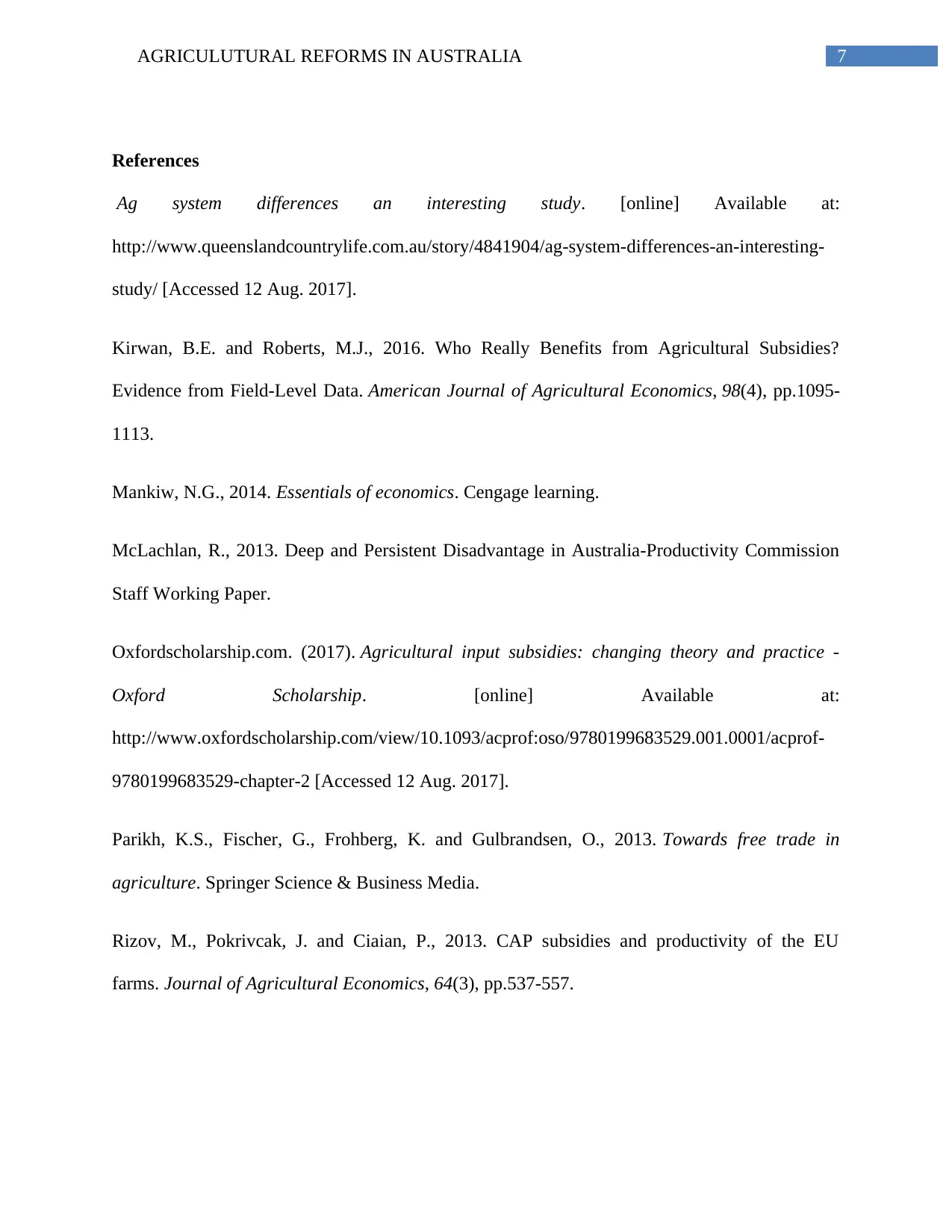
7AGRICULUTURAL REFORMS IN AUSTRALIA
References
Ag system differences an interesting study. [online] Available at:
http://www.queenslandcountrylife.com.au/story/4841904/ag-system-differences-an-interesting-
study/ [Accessed 12 Aug. 2017].
Kirwan, B.E. and Roberts, M.J., 2016. Who Really Benefits from Agricultural Subsidies?
Evidence from Field-Level Data. American Journal of Agricultural Economics, 98(4), pp.1095-
1113.
Mankiw, N.G., 2014. Essentials of economics. Cengage learning.
McLachlan, R., 2013. Deep and Persistent Disadvantage in Australia-Productivity Commission
Staff Working Paper.
Oxfordscholarship.com. (2017). Agricultural input subsidies: changing theory and practice -
Oxford Scholarship. [online] Available at:
http://www.oxfordscholarship.com/view/10.1093/acprof:oso/9780199683529.001.0001/acprof-
9780199683529-chapter-2 [Accessed 12 Aug. 2017].
Parikh, K.S., Fischer, G., Frohberg, K. and Gulbrandsen, O., 2013. Towards free trade in
agriculture. Springer Science & Business Media.
Rizov, M., Pokrivcak, J. and Ciaian, P., 2013. CAP subsidies and productivity of the EU
farms. Journal of Agricultural Economics, 64(3), pp.537-557.
References
Ag system differences an interesting study. [online] Available at:
http://www.queenslandcountrylife.com.au/story/4841904/ag-system-differences-an-interesting-
study/ [Accessed 12 Aug. 2017].
Kirwan, B.E. and Roberts, M.J., 2016. Who Really Benefits from Agricultural Subsidies?
Evidence from Field-Level Data. American Journal of Agricultural Economics, 98(4), pp.1095-
1113.
Mankiw, N.G., 2014. Essentials of economics. Cengage learning.
McLachlan, R., 2013. Deep and Persistent Disadvantage in Australia-Productivity Commission
Staff Working Paper.
Oxfordscholarship.com. (2017). Agricultural input subsidies: changing theory and practice -
Oxford Scholarship. [online] Available at:
http://www.oxfordscholarship.com/view/10.1093/acprof:oso/9780199683529.001.0001/acprof-
9780199683529-chapter-2 [Accessed 12 Aug. 2017].
Parikh, K.S., Fischer, G., Frohberg, K. and Gulbrandsen, O., 2013. Towards free trade in
agriculture. Springer Science & Business Media.
Rizov, M., Pokrivcak, J. and Ciaian, P., 2013. CAP subsidies and productivity of the EU
farms. Journal of Agricultural Economics, 64(3), pp.537-557.
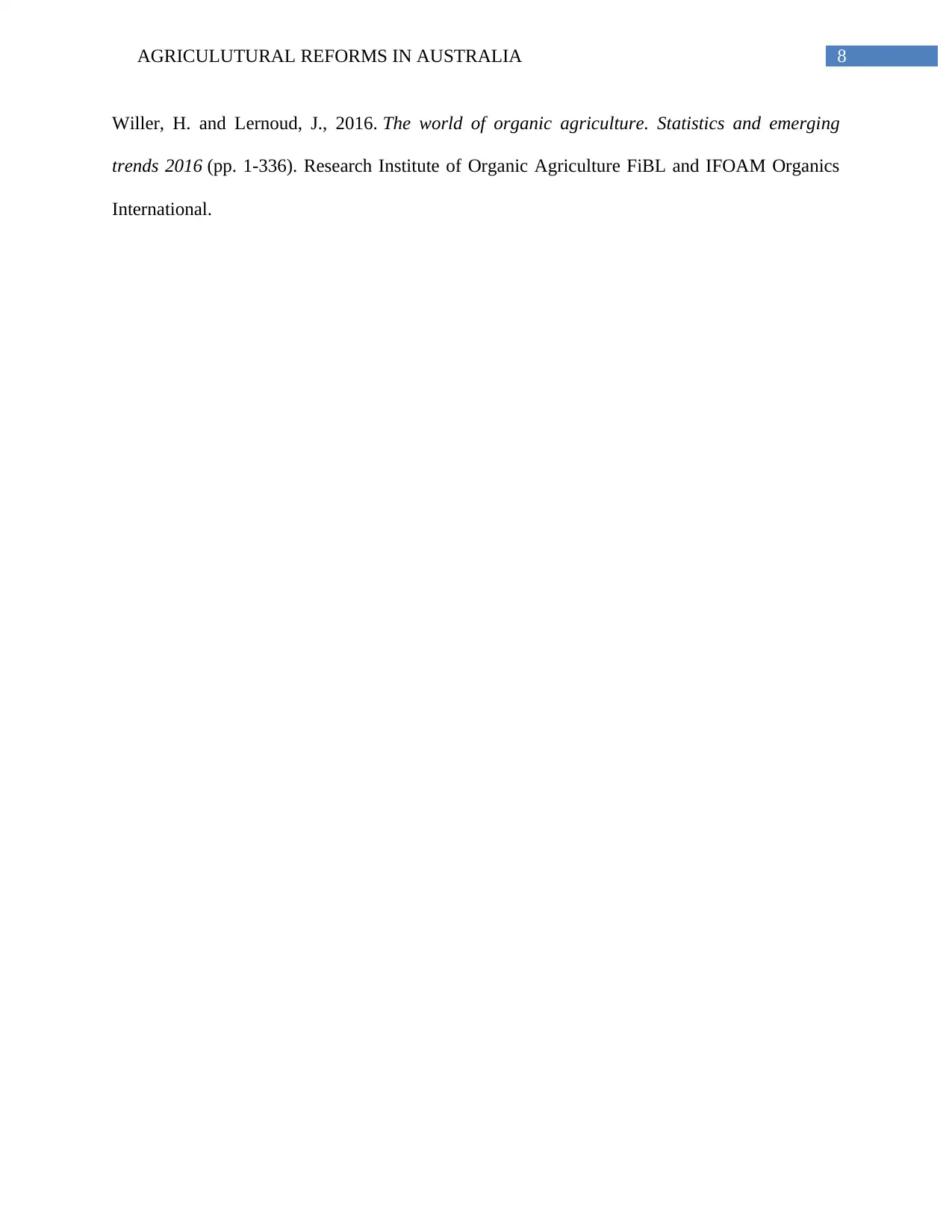
8AGRICULUTURAL REFORMS IN AUSTRALIA
Willer, H. and Lernoud, J., 2016. The world of organic agriculture. Statistics and emerging
trends 2016 (pp. 1-336). Research Institute of Organic Agriculture FiBL and IFOAM Organics
International.
Willer, H. and Lernoud, J., 2016. The world of organic agriculture. Statistics and emerging
trends 2016 (pp. 1-336). Research Institute of Organic Agriculture FiBL and IFOAM Organics
International.
⊘ This is a preview!⊘
Do you want full access?
Subscribe today to unlock all pages.

Trusted by 1+ million students worldwide
1 out of 9
Related Documents
Your All-in-One AI-Powered Toolkit for Academic Success.
+13062052269
info@desklib.com
Available 24*7 on WhatsApp / Email
![[object Object]](/_next/static/media/star-bottom.7253800d.svg)
Unlock your academic potential
Copyright © 2020–2025 A2Z Services. All Rights Reserved. Developed and managed by ZUCOL.





